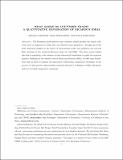What Goods Do Countries Trade? A Quantitative Exploration of Ricardo’s Ideas
Author(s)
Costinot, Arnaud; Donaldson, David John; Komunjer, Ivana
DownloadCostinot_What Goods.pdf (299.6Kb)
OPEN_ACCESS_POLICY
Open Access Policy
Creative Commons Attribution-Noncommercial-Share Alike
Terms of use
Metadata
Show full item recordAbstract
The Ricardian model predicts that countries should produce and export relatively more in industries in which they are relatively more productive. Though one of the most celebrated insights in the theory of international trade, this prediction has received little attention in the empirical literature since the mid-1960s. The main reason behind this lack of popularity is the absence of clear theoretical foundations to guide the empirical analysis. Building on the seminal work of Eaton and Kortum (“Technology, Geography, and Trade”, Econometrica, 70, 1741–1779 2002), we offer such foundations and use them to quantify the importance of Ricardian comparative advantage. In the process, we also provide a theoretically consistent alternative to Balassa's (1965, “An Empirical Demonstration of Classical Comparative Cost Theory”, Review of Economics and Statistics, 45, 231–238) well-known index of “revealed comparative advantage”.
Date issued
2011-09Department
Massachusetts Institute of Technology. Department of EconomicsJournal
Review of Economic Studies
Publisher
Oxford University Press
Citation
Costinot, A., D. Donaldson, and I. Komunjer. “What Goods Do Countries Trade? A Quantitative Exploration of Ricardo’s Ideas.” The Review of Economic Studies 79.2 (2011): 581–608. Web.
Version: Author's final manuscript
ISSN
0034-6527
1467-937X